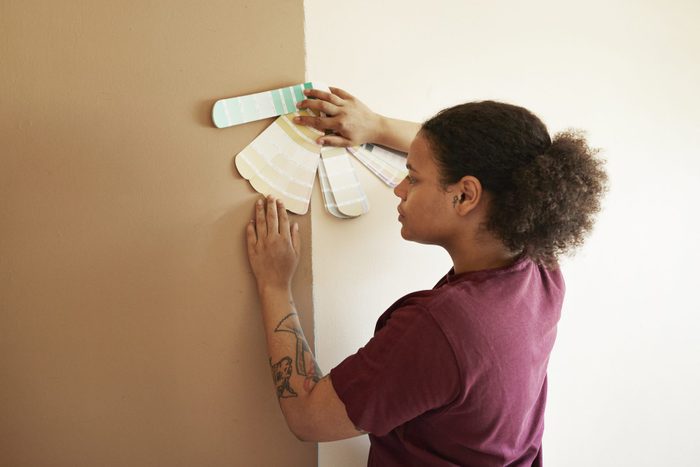How To Match Paint Already on a Wall

Painted walls in our homes take the brunt of the dings and scrapes of life. Match paint already on a wall and brighten any room with these tips.
Our editors and experts handpick every product we feature. We may earn a commission from your purchases.
Painted walls in a home are durable, attractive and mostly maintenance-free. Once pictures and furniture are in place, we tend to forget about them until it’s time to move stuff around.
But chips, scuffs and holes add up over time. And once we notice them, they’re all we see. The good news is, you don’t have to hire a professional painter to freshen those walls. But you can’t just start flinging paint on the wall, either.
My sister offered to “touch up” my mom’s entry hall last year, and the results make us laugh to this day. Vincent van Gogh couldn’t have painted more vividly-noticeable brushstrokes. (Guess what I’ll be doing next week?)
Did you know that paint doesn’t magically blend with the same color, even if you bought them at the same time? That’s why professionals “box,” aka mix, cans of the same color paint together before applying. (At home, you can do this in a five-gallon bucket.)
But what if you’re trying to match paint already on a wall? Is it possible to get a good match? “Absolutely,” says Tyler Wigington, the store manager at Sherwin-Williams in Dallas.
While it’s best if you have a spare can from the original job, Wigington says advanced paint-matching technologies and proper techniques make it easier than ever for homeowners to get the most seamless results possible.
On This Page
Find the Best Paint Match
This is the most important step in the process. Unless you plan to paint an entire wall — which is a good option for major damage — precisely matching the paint color and sheen is key to a successful touch-up.
Read on for the best ways to match paint already on a wall when you don’t have the original paint can, backup gallon or brand name.
Paint chip from wall
Take a physical chip from your wall into the paint store. Employees will use a machine called a spectrophotometer to analyze the chip and give a precise color analysis, as well as tell you the sheen.
With a sharp knife, cut a piece at least the size of a quarter (the bigger the better, says Wigington). You don’t have to go deep; just strip off the first layer of paint and drywall paper. The chip needs to be in one piece.
Do this in an inconspicuous area and apply drywall joint compound to skimcoat over the cutaway section. Lightly sand once dry, and paint using the tips below.
If your walls are lath-and-plaster, it’s more difficult, because plaster is extremely hard and tends to crumble. Try cutting down to the lath with a jab saw and carefully scraping away the plaster behind the paint, but be prepared for a mess. Another method of matching is probably best.
Paint-matching apps and scanners
Paint matching apps analyze paint color and sheen with smartphone technology and handheld scanners. Hold the scanner up to the wall and the device does the rest.
You can also upload a picture directly, without the scanner, and the app will find the closest match. Most apps are free or inexpensive. Handheld colorimeters (scanners) can cost up to $100.
Picture of paint on the wall
Take a picture of your wall in natural light and bring it to the paint store. The same spectrophotometer that works on the paint chip can also match the paint from the picture, or get close.
This works best if you’re painting an entire wall, not just a patch, Wigington says. It won’t be perfect, but with proper technique, you’ll be the only one who notices.
Paint chip from store
As a last resort, try to match the paint visually with standard paint chips found at paint stores. Bring home several and hold them up in different lighting. As with the picture method, this works best if you paint the entire wall.
How To Apply Touch-up Paint
Once you match the right color, try the painting techniques below for the best results. Fix small holes, like from a picture hanger, with patching compound. Larger holes need a drywall patch, which you can buy as a kit or DIY.
Sand, clean and prime your wall before painting. Dirt and grime prevent paint from adhering, so don’t skip the prep work.
Corner to corner
Paint the entire wall “corner to corner” for best results, says Wigington, even if you find the perfect paint match. Slight differences in paint color are much less noticeable when they meet along an edge. This is a good idea if you have multiple spots on the same wall to patch and paint.
Feathering
Often it’s not the color that’s so noticeable but the difference in the thicknesses of the paint layers.
Load the tip of your brush and apply to the center of the patch. Use the brush (don’t reload) to drag out, or feather, the new paint into the old. A high-quality paint brush minimizes brushstrokes.
Foam brushes and rollers
Go with a foam brush for small patches on smooth walls professionally sprayed or rolled, Wingington says. Use a light touch, and extend past the edges of the patch slightly by repeatedly lifting and dabbing with the end of the brush.
If your patch job is larger than a nail hole, use a mini roller and don’t load it fully. Starting from the center of the patch, roll outward with the least amount of paint possible at the edges.
Dilute the new paint
As paint dries, the moisture in it evaporates into the air and wicks into the surface of the wall. New paint wicks at a different rate than the original paint, so experts at Sherwin-Williams recommend diluting the new paint slightly (five to 10 percent for water-based paints). This slows the wicking rate and helps the new paint blend into the old.



